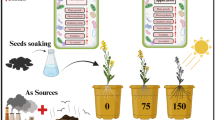Abstract
Arsenic (As) is a highly toxic metalloid present naturally in the earth’s crust. In developing countries apart from drinking water, one major reason for arsenic toxicity among human beings is through contaminated crops and vegetables. The nutritional quality of the crops and vegetables grown in the arsenic-infested area gets compromised. A major challenge is to protect the vegetables and crops from arsenic contamination. Attempts have been made through different remediation technologies. The present research is designed to reduce the arsenic load in arsenic-sensitive (non-hyperaccumulator) plants by co-cultivation with hyperaccumulator plants, thus saving food chain contamination to humans. In the present study, done in potted plants, it has been found that co-cultivated B. oleracea has 1.5 times decreased arsenic translocation compared to the control plant; on the contrary, hyperaccumulator B. juncea showed higher translocation. Plant health biomarkers like total chlorophyll and protein contents were two times higher in co-cultivated B. oleracea compared to the As-treated control which actually seconds the fact of less translocation in the co-cultivated plants. The stress marker like proline content, super oxide dimutase, and malondialdehyde content showed a decrease in co-cultivated B. oleracea compared to the control plant grown in arsenic-infested soil which again reflected less stress in co-cultivated plants. From these findings of the research, we can hypothesize that hyperaccumulator B. juncea might save B. oleracea from arsenic-induced toxicity when co-cultivated and thus can save food chain-mediated contamination to human beings.






Similar content being viewed by others
Data Availability
All data generated by experiment are included in the manuscript.
References
Khan, L. R., Sarma, P. B. S., Syaukat, Y., Ahmad, S., Concepcion, R., Sethaputra, S., & Nguyen, P. (2012). Ganges-Brahmaputra-Meghna. Food and Agriculture Organization (FAO) of the United Nations: Rome. Italy, 2012, 1–512.
Chakraborti, D., Singh, S. K., Rahman, M. M., Dutta, R. N., Mukherjee, S. C., Pati, S., & Kar, P. B. (2018). Groundwater arsenic contamination in the Ganga river basin: A future health danger. International Journal of Environmental Research and Public Health, 15, 180. https://doi.org/10.3390/ijerph15020180
Adhikary R. & Mandal V. (2017) Status of As toxicity in ground water in West Bengal, India: A review, MOJ Toxicology, MedCrave, Vol 3, Issue 5.
Adriano DC. ((1986) Trace elements in the terrestrial environment.
Nriagu J.O. (2002) Arsenic poisoning through the ages. In: Frankenberger WT, editors. Environmental chemistry of arsenic.
Mukherjee S., Paul .S, Tarafder T., Dutta A., Roy M., (2019) Effect of soil arsenic on stress markers of plants-The analysis between a hyper and hypo accumulator plant of West Bengal, India, Biotechnology & Biological Sciences Sen et al (Eds), Taylor & Frances Group, London, ISBN 978–0–367–43161–7.
Mondal, P., Majumdar, C. B., & Mohanty, B. (2006). Laboratory based approaches for arsenic remediation from contaminated water; recent developments. Journal of Hazardous Materials, 137(1), 464–479.
International Agency for Research on Cancer-World Health Organization. (2001) IARC Monographs on the evaluation of carcinogenic risks to humans; International Agency for Research on Cancer (IARC), World Health Organization (WHO): Lyon, France.
Zhao, Y., Li, M., Tian, X., Xie, J., Liu, P., Ying, X., Wang, M., Yuan, J., Gao, Y., Tian, F., & Yan, X. (2021). Effects of arsenic exposure on lipid metabolism: A systematic review and meta-analysis. Toxicology Mechanisms and Methods, 31(3), 188–196. https://doi.org/10.1080/15376516.2020.1864537
Selvaraj, K., Sevugaperumal, R., & Ramasubramanian, V. (2015). Phytoextraction: Using Brassica as a hyper accumulator. Biochemistry & Physiology, 4, 172. https://doi.org/10.4172/2168-9652.1000172
Sadasivam S. and Manickam A. (2008) Biochemical methods, New Age International (P) Ltd. Publishers, New Delhi, India.
Zhang, Z., & Huang, R. (2013). Analysis of malondialdehyde, chlorophyll proline, soluble sugar, and glutathione content in Arabidopsis seedling. Bioprotocol, 3, 1–8.
Mellem, J. J., Baijnath, H., & Odhav, B. (2009). Translocation and accumulation of Cr, Hg, As, Pb, Cu and Ni by Amaranthus dubius (Amaranthaceae) from contaminated sites. Journal of Environmental Science and Health. Part A, Toxic/Hazardous Substances & Environmental Engineering, 44, 568–575.
Kosakivska, I. V., Babenko, L. M., Romanenko, K. O., Korotka, I. Y., & Potters, G. (2021). Molecular mechanisms of plant adaptive responses to heavy metals stress. Cell Biology International, 45(2), 258–272. https://doi.org/10.1002/cbin.11503
Debona, D., Rodrigues, F. A., & Datnoff, L. E. (2017). Silicon’s role in abiotic and biotic plant stresses. Annual review of Phytopathology, 55, 85–107.
Singh, H. P., Kaur, S., Batish, D. R., Sharma, V. P., Sharma, N., & Kohli, R. K. (2009). Nitric oxide alleviates arsenic toxicity by reducing oxidative damage in the roots of Oryza sativa (rice). Nitric Oxide, 20, 289–297.
Vázquez, S. L., Esteban, E., & Carpena, R. N. O. (2008). Evolution of arsenate toxicity in nodulated white lupine in a long-term culture. Journal of Agriculture and Food Chemistry, 56, 8580–8587.
Nath, S., Panda, P., Mishra, S., Dey, M., Choudhury, S., Sahoo, L., & Panda, S. K. (2014). Arsenic stress in rice: Redox consequences and regulation by iron. Plant Physiology and Biochemistry, 80, 203–210.
Mishra, S., & Dubey, R. S. (2006). Inhibition of ribonuclease and protease activities in arsenic exposed rice seedlings: Role of proline as enzyme protectant. Journal of Plant Physiology, 163, 927–936.
Acknowledgements
The authors are indebted to the university management for the financial assistance.
Funding
This work was supported by institutional funding, and no external funding agency is involved.
Author information
Authors and Affiliations
Contributions
Susmita Mukherjee (corresponding author): Conceptualization, supervision, methodology, data analysis, and manuscript writing.
Sonali Paul: Supervision, methodology, and data analysis
Sreshtha Saha: Preparing the soil, maintaining the plants, and data curation
Ankit Chakraborty: Preparing the soil, maintaining the plants, data curation, and data analysis
Annapurna Jana: Preparing the soil, maintaining the plants, and data curation
Corresponding author
Ethics declarations
Ethics Approval
Not applicable.
Competing Interests
The authors declare no competing interests.
Additional information
Publisher’s Note
Springer Nature remains neutral with regard to jurisdictional claims in published maps and institutional affiliations.
Rights and permissions
About this article
Cite this article
Paul, S., Saha, S., Chakraborty, A. et al. Co-cultivation as a Strategy to Reduce Food Chain-Mediated Arsenic Contamination in Human Beings. Appl Biochem Biotechnol 195, 2252–2260 (2023). https://doi.org/10.1007/s12010-022-03987-5
Accepted:
Published:
Issue Date:
DOI: https://doi.org/10.1007/s12010-022-03987-5




